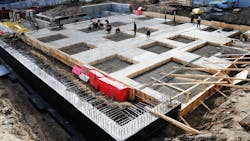What Are the Best Foundations for Commercial Building Stability?
Every building project needs a solid foundation. While that may seem obvious, which type of foundation is best is often less clear. Commercial buildings further complicate the matter, as their higher budgets allow for more options, but they face more stringent requirements.
Choosing the right foundation for your project starts with knowing your options. Here are five of the best foundation types for commercial building stability.
1. Mat Foundations
While concrete slab foundations may be the most common choice, they are not ideal for many commercial projects. Mat or raft foundations offer a similar but more reliable alternative.
Mats provide similar simplicity and resistance against the elements as slab-on-grade foundations but distribute weight more evenly. This distribution can reduce differential settlement, which climate change may make more common in the future. Rafts also enable basements, which commercial buildings are more likely to have than residential structures in many areas.
On the other hand, mat foundations are shallow. That could be an advantage in projects with firm soil and smaller buildings, as it requires less work to install. However, this shallowness could introduce frost or compaction concerns in other soil conditions.
2. Drilled Shafts
Poor soil is the enemy of commercial building stability, but looking beyond slabs and mats can help you overcome this challenge. Drilled shafts, for example, are an optimal foundation choice when dealing with weak soil or uneven surfaces.
Shafts—also called drilled piers or caissons—often go dozens of meters into the ground, offering significant stability benefits. This stability makes them a popular choice for multi-story commercial buildings or those near water. Smaller buildings can benefit from them, too, as the caissons will go deep enough to offset risks from loose soil or water-related hazards.
The biggest downside of drilled shafts is that they can be expensive and complex to install, especially where water is involved. They are more cost-effective when hazards are less prominent, but this means the projects that need them most will find them the most challenging to implement.
3. Pile Foundations
Piles are another reliable option when projects need a deeper foundation. Like caissons, piles can go past weak upper soil levels to provide strength against erosion, water or loose ground. Unlike caissons, these foundations use simpler columns, which can reduce costs and complexity in some projects.
Driven piles are a common choice in underwater construction, highlighting their strength and resilience against water hazards. However, they often don’t go as deep as drilled shafts. Consequently, they may be a better fit for commercial projects facing tighter budgets or time constraints.
Because piles are typically not as deep as caissons, they may be less suitable for tall or heavy structures. You must also select materials carefully when using these foundations. Steel piles provide excellent strength but can be expensive and corrode in high moisture, while concrete is cheaper but may crack without reinforcement.
4. T-Shaped Foundations
In some cases, older methods are still the best. T-shaped foundations have been around in colder climates for a long time but remain an optimal choice for commercial building stability.
T-shaped foundations are most popular as a way to protect against frost, as the footing lies below the frost line. Roughly 50% of the Northern Hemisphere freezes in cold seasons, so many commercial projects should consider this option. Even in areas without frost, T-shaped foundations are favorable for their weight distribution and support for taller structures.
While T-shaped foundations are among the strongest, they also entail high upfront costs. Similarly, they take a long time to install, so they may not be the best choice when facing tight deadlines, especially for smaller projects.
5. Spread Footing
Some commercial buildings may find that spread footing offers the highest cost-to-benefit ratio. While these foundations are more common in residential projects, they are still suitable for smaller commercial structures.
Spread footing provides more stability than slabs and is more resistant to cracking. Using several small supports instead of a single large one also means that one failure will not jeopardize the entire structure. This method is also affordable and easy to install, especially compared to alternatives like drilled shafts or T-shaped foundations.
Like mat foundations, spread footing is shallow, so it is only applicable in areas with good soil conditions. Differential settlement is also a significant risk factor with this method, so larger structures should use a different option.
Other Considerations for Commercial Building Stability
These five foundation styles are among the best for any commercial building. However, ensuring stability is about more than your foundation. You must also consider several other factors for these structures to provide their full benefits.
One of the most important steps is performing a soil test before choosing a foundation type. Unstable ground can cause foundations to shift and create safety hazards for workers when laying them. Measuring soil compaction, moisture content and strength will reveal how weak or prone the ground is to change. You can then determine if you need a deeper foundation method.
Geotechnical engineering can work alongside the right foundation to improve your building’s stability. Retaining walls, ground anchors and similar infrastructure will make the ground more stable to ensure the elements will not push your foundation to its limits.
Similarly, you must ensure proper drainage to minimize water hazards near your foundation. The International Building Code says drains must extend at least 12 inches beyond the footing and use approved materials. Projects in hazard-prone areas may consider installing Internet of Things sensors to enable ongoing monitoring of drainage and related conditions for faster emergency responses.
Build Your Next Project on the Right Foundation
As environmental risks rise, choosing the right foundation for commercial buildings will become all the more crucial. Even in low-risk areas, these choices have significant implications for safety, stability, costs and project timelines. In light of this gravity, learning about your foundation options is essential.
The best foundation depends on the specific project. However, some methods are more reliable than others across various use cases. Begin with these five options when determining the foundation for your next commercial project to make the best possible choice.
About the Author

Emily Newton
Emily Newton is an industrial and tech journalist passionate about how technology is revolutionizing each sector. She has been writing and editing professionally for more than five years and is the editor-in-chief of Revolutionized.
